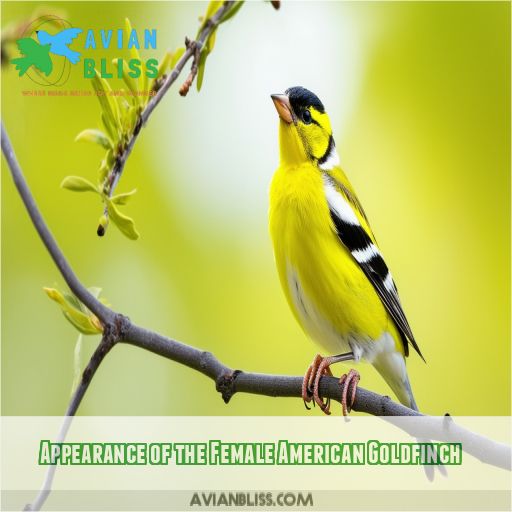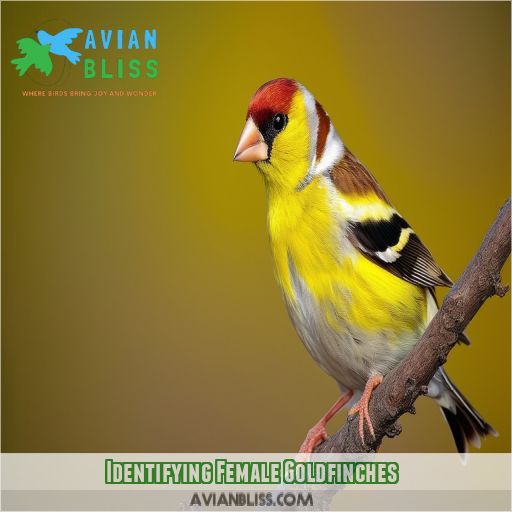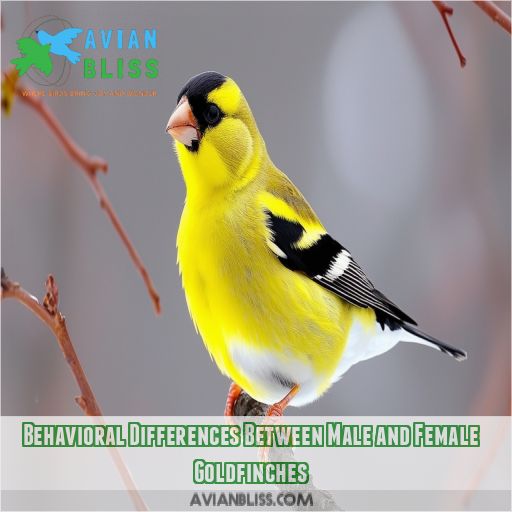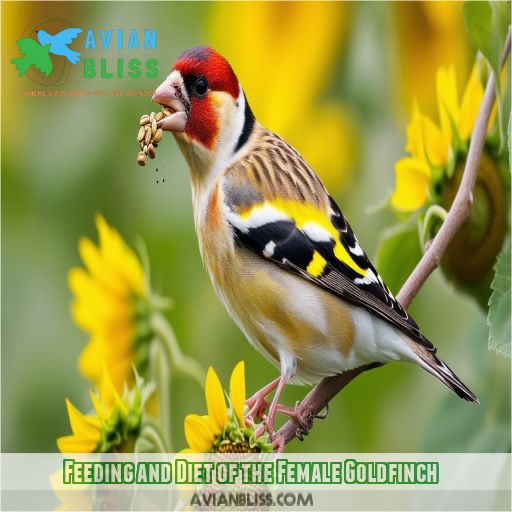This site is supported by our readers. We may earn a commission, at no cost to you, if you purchase through links.
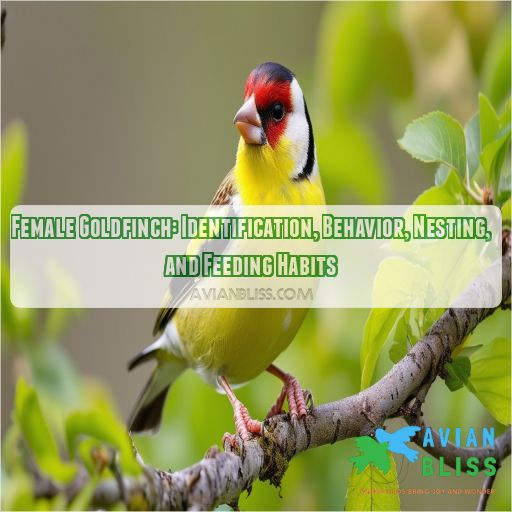
Learn to identify her by her olive back, pale yellow belly, and distinctive pale orange bill.
Get to know her characteristics—a little less vocal and much less aggressive than males; however, it is very important in nest building and incubation.
Note her nesting habits in saplings and shrubs and explore her primarily seed-based diet, occasionally flavored with insects in the summer.
Join us in celebrating this understated avian gem
Table Of Contents
- Key Takeaways
- Appearance of the Female American Goldfinch
- Identifying Female Goldfinches
- Behavioral Differences Between Male and Female Goldfinches
- Nesting Habits of Female American Goldfinches
- Feeding and Diet of the Female Goldfinch
- Conservation Status and Threats to Female Goldfinches
- Frequently Asked Questions (FAQs)
- What color is the female goldfinch?
- How do you tell the difference between a male and female goldfinch?
- Is there another bird that looks like a goldfinch?
- How rare is it to see a goldfinch?
- What is the difference between male and female goldfinches?
- Are there a male and female Lawrence’s goldfinches?
- What does a male goldfinch look like?
- How do you know if a goldfinch is female?
- How long do female goldfinches live?
- Do female goldfinches migrate in the winter?
- What sounds do female goldfinches make?
- How do female goldfinches select a mate?
- Are female goldfinches social birds?
- Conclusion
Key Takeaways
- Meet the female goldfinch, the unsung heroine of the avian world, with her olive-colored back and pale orange bill. She may not be as flashy as her male counterpart, but her subtle beauty and vital role in nest-building and incubation make her a true gem.
- The female goldfinch is a master of camouflage, blending seamlessly into her surroundings with her duller plumage. She’s like a secret agent in the bird world, quietly observing and navigating her environment with ease.
- Unlike her male counterpart, the female goldfinch is a bit more reserved and less aggressive. She’s more of a peacemaker, sharing feeders with other birds without causing a fuss.
- The female goldfinch’s diet is primarily seed-based, but she’ll occasionally indulge in a tasty insect or two. Her favorite seed spots are weeds, grasses, and the daisy family. Think of her as the avian version of a vegetarian with a sweet tooth for bugs!
Appearance of the Female American Goldfinch
The female American Goldfinch is characterized by her olive-colored back, pale yellow abdomen, and overall duller appearance compared to males. She also has a pale orange bill that differentiates her from other birds
Olive-colored Back
The female goldfinch boasts an olive-colored back, giving her a distinct, earthy look. This olive coloration blends effortlessly with her preferred habitats like shrubs and saplings. Whether foraging for seeds or selecting nesting sites, this subtle hue offers effective camouflage from predators, ensuring safety in her natural habitat
Pale Yellow Abdomen
The female goldfinch has a pale yellow abdomen, distinct yet subtle. This hue is especially noticeable during the breeding season. It contrasts with their olive back and provides camouflage in their nesting location. Their diet of seeds contributes to their coloration, which changes to a duller shade in the non-breeding season
Duller Than Males
The female goldfinches are much more subdued in color than the males, with their olive-colored back and abdomen a pale yellow. Generally, they’re much duller than the male species, plumage less intensely yellow.
In this way, such sexual dimorphism will help you identify them as being of a much less aggressive nature than their more brightly colored male cousins in the goldfinch species
Pale Orange Bill
You can identify a female goldfinch by her pale orange bill, which stands out, especially during the breeding season. This bill color helps differentiate females from males. Remember:
- Look for a paler bill than the male’s brighter orange.
- Notice the bill color during foraging.
- Spot it in nest-building activities
Identifying Female Goldfinches
To identify a female goldfinch, look for grayish tail feathers with dull white spots and a yellowish-brown to gray winter plumage. The female also has a buff to tawny brown coloration above, distinguishing her from her brighter-colored male counterpart
Grayish Tail Feathers
The female goldfinch is distinguishable by her grayish tail feathers, which integrate subtly into the overall female size. These gray feathers contrast against her olive back and pale yellow abdomen, aiding in camouflage within her habitat. Understanding these features enhances your identification skills for female goldfinches in the wild
Dull White Spots on Tail
Female goldfinches can be identified by their grayish tail feathers marked with dull white spots. These subtle distinctions, known as tail feather markings, set them apart from their more vibrant male counterparts. Additionally, female goldfinches often select nesting habitats in shrubs or saplings, highlighting their unique identification markers and behavior
Yellowish-brown to Gray Winter Plumage
In winter, female goldfinches shift to a yellowish-brown to gray plumage. This seasonal change in female coloration helps them blend into their habitats better. Unlike the males, whose bright yellow fades, females take on a subtler palette, aiding in survival through changing weather and migration patterns during the non-breeding season
Buff to Tawny Brown Above
When identifying female goldfinches, look for their buff to tawny brown above, which sets them apart from males. This juvenile coloration helps spot young and non-breeding females. In winter, their muted tones aid in blending with surroundings, making them less noticeable. Their appearance contrasts sharply with the bright male plumage
Behavioral Differences Between Male and Female Goldfinches
Female goldfinches are less vocal and less aggressive toward other birds than their male counterparts. They build nests and incubate the eggs, playing a crucial role in reproduction
Females Less Vocal
When identifying female goldfinches, you’ll notice their vocalizations are subtle and less frequent compared to males. This behavior is linked to their less vibrant plumage and reduced need to defend territory or attract a mate.
Female flight calls are softer and less varied, reflecting their role in nesting and caretaking.
Understanding these behavioral nuances simplifies goldfinch identification, emphasizing their quieter, nurturing nature
Females Less Aggressive Toward Other Birds
Compared to their male counterparts, female goldfinches exhibit less aggressive behavior toward other birds. This sexually dimorphic behavior often means you’ll see them sharing feeders more peacefully.
With their dull yellow and olive coloration, female goldfinches navigate habitats with ease, feeding primarily on sunflower and thistle seeds. Despite their quieter demeanor, they still engage in occasional territorial disputes, but their main focus remains on foraging and sustaining their wild canary lineage
Females Build Nest and Incubate Eggs
The females build their nests in saplings or shrubs, always choosing locations where the branches join high above the ground. The female uses plant fibers and rootlets in building a sturdy, compact cup lined with plant down.
The female incubates the eggs, which usually take about 12 to 14 days before hatching; they diligently ensure that the climatic condition around the chicks is stable while they develop. Thus, the role of a female during nesting becomes very vital for the continuation of its species
Nesting Habits of Female American Goldfinches
Female American Goldfinches build their nests in saplings or shrubs, using plant fibers and rootlets, then line them with plant down. These nests are located typically high up where the branches join, and the incubation period is 12-14 days
Nest Built in Sapling or Shrub
You’ll find the female American goldfinch‘s nest nestled high up in the branches of a sapling or shrub, where the limbs come together. Her dull yellow plumage blends in as she carefully constructs her cozy home, weaving plant fibers and rootlets into a sturdy, compact cup
Nest Made From Plant Fibers and Rootlets
During constructing their nests, the female goldfinches select plant fibers and rootlets.
The chosen material is twisted and weaved to strengthen the base and make it secure.
The use of such plant material in its construction ensures a vital structure that can bear the forces of different elements.
Their nesting habitats are usually saplings or shrubs, which support their nest defense strategies
Nest Lined With Plant Down
The female American Goldfinch carefully lines her nest with soft plant down so that the environment inside would be warm enough to prevent her eggs from getting cold. The architecture of this nest enhances insulation and comfort. Key features of this include:
- Location: High up in saplings or shrubs.
- Materials: Fibrous seeds, rootlets, and plant down.
Breeding Timing: Mostly in July-August
Incubation Period: 12-14 Days
During this incubation period of 12-14 days, the female goldfinch is assiduous in her care for the nest, typically placing it in a sapling or shrub to maximize its camouflage. Females guard their nests vigorously against predators but desert them if threatened. Seeing wild, plant fiber and down nests testify to nature’s ingenuity in nest construction.
Feeding and Diet of the Female Goldfinch
Female goldfinches primarily eat seeds, especially from weeds, grasses, and the daisy family. In summer, they also consume buds, young twig bark, and small insects, while feeding their young with regurgitated seeds
Primarily Eats Seeds
The female American Goldfinch primarily eats seeds, focusing on small-seeded plants. Her diet includes:
- Seeds of the daisy family
- Seeds from weeds and grasses
- Nutrient-rich composite seeds
- Seasonal variation – changing seed preferences based on availability
These strategies maximize her nutritional intake throughout North Carolina’s seasons
Eats Buds and Bark of Young Twigs
Female goldfinches also consume buds and bark from new twigs, gaining vital nutrition. The female is unmistakably unlike the male counterpart, as she’s a plain grayish face without the black face patch. So this action helps them acquire diversified nutrition that’s important to such areas as Northwest Mexico with varying foods.
Feeds on Insects to a Limited Extent in Summer
In summer, the female goldfinch supplements her primarily seed-based diet with a limited amount of insects. Her distinctive black back and lemon yellow belly make her easy to spot as she flits from flower to flower, hunting for small bugs to feed herself and her young. This behavior is similar to that of the closely related Lawrence’s goldfinch
Feeds Young Regurgitated Seeds
Female goldfinches feed regurgitated seeds to their young ones—bright, careful selection for nutrition. It’s the adaptation of the beak that functioned in such a way that it was better to collect and grind seeds.
The exact choice thus ensures that the chicks grow strong fast, hence supporting them on independence.
Song differences reveal mating behavior, but strong seed choice remains crucial to survival
Conservation Status and Threats to Female Goldfinches
Female goldfinches are widespread and very common, but they face increased risks due to diseases and extreme weather events. These threats could impact their food sources, nesting habitats, and overall population stability
Widespread and Very Common
Despite being widespread and very common, the female Goldfinch faces several population trends you should be aware of. Habitat loss and altered food availability play significant roles in their numbers.
Changes in migration patterns due to climate change also affect their distribution and reproductive success. On top of that, their habitats are shrinking as urban development spreads.
Despite these challenges, conservation measures like protecting native plant species and maintaining natural habitats can help sustain their populations. Ensuring these measures are in place allows these charming birds to continue brightening our landscapes with their presence and beauty for years to come
Increased Risk of Disease and Extreme Weather Events
With female goldfinches being widespread and common, they’re not immune to threats. Climate change exposes them to increased disease prevalence and extreme weather impacts. Here are four key threats:
- Habitat Loss: Urbanization and deforestation reduce nesting sites.
- Extreme Weather: Storms and heatwaves affect their survival and breeding cycles.
- Disease Prevalence: Warmer temperatures amplify parasite and disease rates.
- Food Availability: Climate change alters the availability of seed sources.
Conservation measures like planting native plants, reducing pesticide use, and supporting climate change mitigation efforts can help protect these delicate creatures. They need a safe, nurturing environment to thrive
Frequently Asked Questions (FAQs)
What color is the female goldfinch?
The female goldfinch is typically olive-colored with a pale yellow abdomen. She’s duller tones compared to the male, with buff wingbars and a pale orange bill. Her tail is mostly black with pale underneath
How do you tell the difference between a male and female goldfinch?
To tell male and female goldfinches apart, look for the male’s bright yellow feathers and black forehead, wings, and tail. The female is duller, with olive-colored back and pale yellow abdomen
Is there another bird that looks like a goldfinch?
You might mistake an American Goldfinch for a Pine Siskin. Both birds share similar markings and size. However, Pine Siskins have sharper streaks on their brown bodies, lack the bright yellow colors, and exhibit more erratic flight patterns
How rare is it to see a goldfinch?
Seeing a goldfinch isn’t too rare; they’re fairly common across North America, especially in gardens and parks. However, their numbers can fluctuate with seasons and regional conditions, making sightings a bit less predictable
What is the difference between male and female goldfinches?
Ever wondered how to spot the difference between male and female goldfinches? Males flaunt bright yellow plumage with black wings and tails, while females are generally olive-backed with a dull yellow abdomen and less vibrant
Are there a male and female Lawrence’s goldfinches?
Yes, there are male and female Lawrence’s goldfinches. Males are bright yellow with black heads and wings, while females are more subdued, with olive-gray backs and paler yellow underparts. Both share the characteristic black wings
What does a male goldfinch look like?
Imagine spotting a vibrant field—male goldfinches stand out with their bright yellow color, black forehead, and wings, white markings, and short, conical bills. Their eye-catching appearance makes them unforgettable as they flit among the shrubs
How do you know if a goldfinch is female?
You can tell a goldfinch is female by its duller, olive-yellow color, pale yellow abdomen, and buff wingbars. Females lack the males’ black forehead and have an overall subdued appearance with a more olive back
How long do female goldfinches live?
Like a poet’s fleeting verse, female goldfinches often live around 3-6 years in the wild. These resilient birds, however, have been known to reach up to 10 years, adapting to life’s unpredictable symphony
Do female goldfinches migrate in the winter?
Yes, female goldfinches migrate in the winter. They often move to the southern United States or Mexico. Migration depends on food availability, so you might see fluctuations in their migration patterns each year
What sounds do female goldfinches make?
Female goldfinches make a quick sequence of high-pitched notes, especially when their mate brings food. They also produce courtship calls, and alarm and threat calls to communicate their needs and concerns within their environment
How do female goldfinches select a mate?
Female goldfinches chose a mate based on the brightly colored plumage of the male, his singing prowess from high perches, and field-acrobatic displays of flight. Appearance and energy displays were thus two of the more important criteria.
Are female goldfinches social birds?
Friendly female goldfinches frequently frolic with flocks outside breeding seasons. You’ll often find them foraging together, fluttering from plant to plant. Their sociable nature fosters a sense of belonging and community within their bird bands
Conclusion
Knowing what a female goldfinch looks and acts like enhances your bird-watching experience. You’ll recognize her from her olive-colored back and pale orange bill, distinguishing her from the brilliant male.
You’ll know her nature compared to that of the male—less noisy, less aggressive—but learn to respect her for the part she plays in nest construction and incubation.
Her seed-based diet completes this knowledge. So, in a pretty understated package, a female goldfinch holds much information about living life as a bird: beautiful and complex

